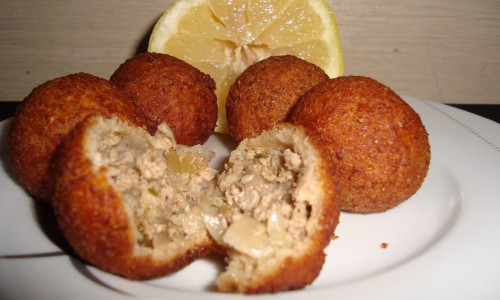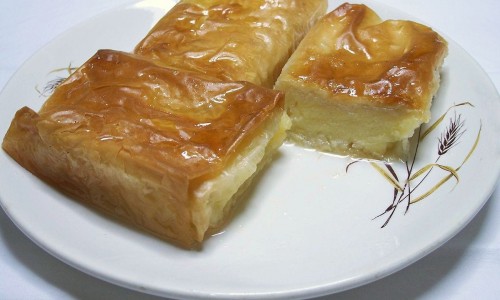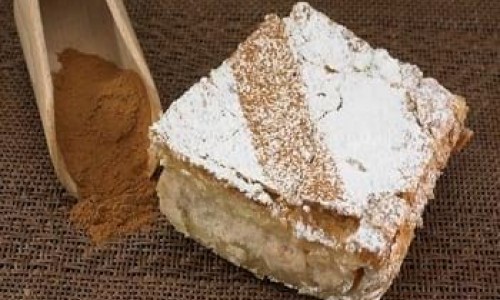Eliopita
In the hills and coastal villages of Cyprus, where olive trees have flourished for thousands of years, the humble Eliopita holds a special place in every Cypriot kitchen. Often eaten warm from the oven with a cup of Cypriot coffee or shared among friends at village gatherings, this rustic olive pie is more than just food—it's a beloved emblem of the island’s heritage, simplicity, and connection to the land.
What Exactly Is Eliopita?
At its heart, Eliopita (Greek: Ελιόπιτα) is a savory pie filled with chopped black olives, onions, herbs, and olive oil, all encased in a golden, tender dough. Its name comes from “elia,” meaning olive, and “pita,” meaning pie.
What makes Eliopita so appealing is its rich, briny flavor, its aromatic herbal undertones, and the slightly chewy, olive oil-infused dough that holds it all together. It’s hearty yet simple, deeply flavorful without being fussy.
A Pie of Many Forms
While Eliopita follows a basic formula, there are many regional and household variations, each with its own character:
- Loaf-style Elioti: A long, rustic olive bread baked in a loaf pan, often sliced and served like cake.
- Hand pies or rolls (Eliopitakia): Individual, round or oval pies, easy to pack in a lunchbox or offer at picnics and festivals.
- Layered pies: Similar to spanakopita in structure, where olive filling is spread between layers of phyllo or homemade dough.
- Braided or spiral pies: Twisted or rolled for visual appeal—especially popular during holiday meals or local celebrations.
Each variation reflects the creativity and resourcefulness of Cypriot home cooks, who often adjusted the recipe based on what they had on hand.
Ingredients & Traditional Additions
While recipes vary slightly, Eliopita typically includes the following ingredients:
For the Dough:
- Plain flour
- Olive oil (generously used for both flavor and moisture)
- Orange juice or warm water
- Baking powder or yeast
- Salt
- Sometimes a splash of zivania or vinegar for tenderness
For the Filling:
- Chopped or crushed black olives (traditionally home-cured)
- Finely chopped onions
- Fresh or dried mint
- Optional: coriander seeds, oregano, fennel leaves, sesame seeds
Some cooks also add:
- Crushed wheat or bulgur for texture
- Sun-dried tomatoes for extra depth
- Capers or spinach as regional twists
- Feta cheese, though this is less traditional and makes it unsuitable for fasting days
The use of orange juice in the dough is a distinctively Cypriot touch, lending a subtle aroma and natural sweetness that balances the saltiness of the olives.
A Dish Rooted in Simplicity and Spirituality
Eliopita is a staple during Lenten fasting periods, when meat, dairy, and eggs are avoided. As a naturally vegan dish, it became a go-to for families during Orthodox religious observances, particularly before Easter and Christmas. Its simplicity made it a symbol of humble, honest food—nourishing and filling without extravagance.
In rural villages, it’s still common for families to make Eliopita using olives from their own trees, herbs from their gardens, and stone-ground flour from local mills. This tradition of using homegrown, seasonal ingredients gives the pie a deeply personal and almost sacred quality.
Baking Rituals and Family Bonds
In many Cypriot homes, making Eliopita is a multi-generational ritual. Grandmothers teach daughters and granddaughters how to knead the dough by hand, how to balance the saltiness of olives with herbs, and how to fold the pies just right. During holidays or name days, it’s common for large batches of Eliopita to be baked, wrapped in cloth, and shared among neighbors.
This act of baking and sharing is as nourishing to relationships as the pie is to the body. It strengthens bonds, preserves culinary memory, and reaffirms the central role of food in Cypriot identity.
How to Enjoy Eliopita
Eliopita is incredibly versatile. It can be eaten warm, at room temperature, or even cold—and it only seems to get better with time. Here are some ways to enjoy it:
- Breakfast: Warm from the oven with coffee or tea.
- Midday snack: Wrapped and packed for school or work.
- Part of a mezze platter: Cut into small squares alongside olives, cucumbers, and dips.
- Picnic fare: Easy to transport and share outdoors.
- Paired with soup or salad: For a light, balanced meal.
Some enjoy it with a dollop of tahini, a wedge of lemon, or a simple tomato salad. It’s filling, flavorful, and deeply satisfying.
A Legacy That Endures
Eliopita may not be as internationally known as halloumi or souvlaki, but it’s an unsung hero of Cypriot cuisine—a dish that encapsulates local agriculture, family values, and culinary creativity. It’s not flashy, but that’s part of its charm. It whispers of olive groves in the breeze, of sun-warmed earth, and the joy of gathering around a table with something simple and good to share.
In a world that often prizes speed and novelty, Eliopita reminds us of the beauty of tradition, the value of patience, and the deep comfort of food that tells a story.






